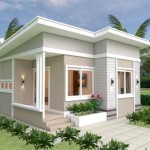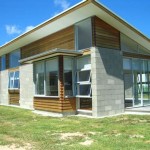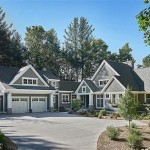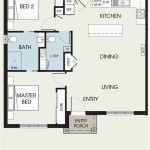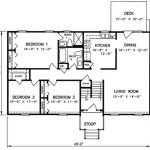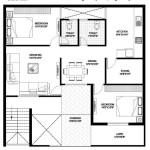Basic Ranch Home Floor Plans: An Overview
Ranch homes, characterized by their single-story layout and open floor plans, offer a blend of simplicity and functionality that appeals to a wide range of homeowners. Understanding the fundamental elements of basic ranch home floor plans is crucial for anyone considering building, buying, or renovating this popular housing style. This article provides a comprehensive overview of the common features, variations, and considerations associated with these designs.
The ranch style emerged in the United States during the 1930s and gained significant popularity in the post-World War II era. Its roots can be traced back to the Spanish Colonial architecture of the Southwest, with its emphasis on horizontal lines and connection to the outdoors. The appeal of ranch homes lies in their accessibility, ease of maintenance, and potential for customization. The single-story design eliminates the need for stairs, making them suitable for individuals of all ages and mobility levels. The open floor plans foster a sense of spaciousness and facilitate social interaction.
A typical ranch home floor plan features a long, low-pitched roofline, large windows, and an attached garage. The interior layout is typically divided into two main zones: living areas and sleeping areas. The living areas, which include the living room, dining room, and kitchen, are usually located at the front of the house, while the bedrooms and bathrooms are situated at the rear. The open floor plan concept often connects these spaces, creating a seamless flow between the different areas of the home.
Key Features of Basic Ranch Home Floor Plans
Several defining characteristics distinguish basic ranch home floor plans from other architectural styles. These features contribute to the overall functionality and aesthetic appeal of the design.
One of the most prominent features is the single-story layout. This eliminates the need for stairs, making the home easily navigable for individuals with mobility limitations. It also simplifies tasks such as laundry and grocery carrying, as everything is located on a single level. The absence of stairs also contributes to a sense of openness and spaciousness within the home.
Another key feature is the open floor plan. The living room, dining room, and kitchen are often combined into a single, large space. This creates a more social and interactive environment, perfect for entertaining guests or spending time with family. The open floor plan also allows for better natural light penetration and improved airflow throughout the home.
Attached garages are also a common feature of ranch homes. This provides convenient and secure parking for vehicles, as well as additional storage space. Attached garages often include a direct entry into the home, making it easy to transport groceries and other items, especially during inclement weather.
Large windows are another hallmark of ranch-style homes. These windows allow for ample natural light to enter the home, creating a bright and airy atmosphere. They also provide views of the surrounding landscape, connecting the interior spaces with the outdoors. In many ranch homes, sliding glass doors lead from the living areas to a patio or backyard, further blurring the boundaries between indoor and outdoor living.
Variations in Ranch Home Floor Plans
While basic ranch homes share common features, there are also several variations in floor plans that cater to different needs and preferences. These variations can be based on size, layout, and style.
One common variation is the split-level ranch. In this design, the home is divided into three or more levels, with short flights of stairs connecting them. This allows for a more efficient use of space, particularly on smaller lots. Split-level ranches often feature a living area on the main level, bedrooms on the upper level, and a family room or recreation room on the lower level.
Another variation is the raised ranch, also known as a split-entry ranch. In this design, the entrance is located on a mid-level, with a short flight of stairs leading up to the main living areas and a short flight of stairs leading down to the lower level. Raised ranches are often built on sloped lots, with the lower level partially or fully below grade.
Another design is the L-shaped ranch. This floor plan features two wings that meet at a right angle, creating an L-shaped footprint. This layout can be used to create a more private outdoor space, such as a patio or garden, within the angle of the L. The L-shape also allows for better separation of the living areas and sleeping areas.
The U-shaped ranch is another design variation. Similar to the L-shaped ranch, this floor plan features three wings that create a U-shaped footprint. This layout is often used to create a central courtyard or patio, providing a protected outdoor space. The U-shape also allows for maximum natural light and ventilation throughout the home.
In terms of size, ranch homes can range from small, one-bedroom designs to large, multi-bedroom estates. The size of the home will depend on the needs of the occupants and the size of the lot. Larger ranch homes may include additional features such as a home office, a media room, or a guest suite.
Factors to Consider When Choosing a Ranch Home Floor Plan
Selecting the right ranch home floor plan involves careful consideration of several factors, including lifestyle, budget, and lot size. A comprehensive assessment of these factors will help ensure that the chosen floor plan meets the needs and preferences of the homeowner.
One of the most important factors to consider is lifestyle. How do you plan to use the home? Do you entertain frequently? Do you work from home? Do you have children or pets? The answers to these questions will help determine the optimal layout and size of the home. For example, if you entertain frequently, you may want to prioritize a large, open living area and a spacious kitchen. If you work from home, you may need a dedicated home office.
The budget is another critical factor. Ranch homes can range in price depending on the size, location, and features of the home. It is important to establish a realistic budget before beginning the search for a floor plan. Consider both the upfront costs of building or buying the home and the ongoing costs of maintenance and utilities.
Lot size is also an important consideration. Ranch homes typically require a larger lot than multi-story homes due to their single-story layout. The size and shape of the lot will influence the design and placement of the home. Consider the setbacks required by local zoning regulations and the orientation of the home to maximize sunlight and views.
Accessibility is another important factor, particularly for individuals with mobility limitations. Ranch homes are generally more accessible than multi-story homes due to the absence of stairs. However, it is important to ensure that the home is designed with accessibility in mind. This may include wider doorways, grab bars in bathrooms, and ramp access to the entrance. Consider the future needs of the occupants as they age.
Energy efficiency should also be a primary consideration. Ranch homes can be prone to energy loss due to their large roof area and single-story construction. Consider incorporating energy-efficient features into the design, such as high-performance windows, insulation, and HVAC systems. A well-insulated and energy-efficient home will save money on utility bills and reduce its environmental impact.
Finally, consider the overall aesthetic appeal of the floor plan. Ranch homes are known for their simplicity and functionality, but they can also be customized to reflect individual style preferences. Consider the exterior design, the interior finishes, and the overall flow of the home. A well-designed ranch home will be both functional and aesthetically pleasing.
In conclusion, understanding the basic elements of ranch home floor plans, including their features, variations, and considerations, is essential for anyone interested in this popular housing style. By carefully considering these factors, homeowners can select a floor plan that meets their needs, preferences, and budget, creating a comfortable and functional living space.

4 Bedroom Classic Ranch House Plan With Covered Porch

Simple To Build Ranch Home Plan 81317w Architectural Designs House Plans

1 400 Square Foot Modular Ranch Home Three Bedrooms And Two Full Bathrooms Signature Building Systems

Ranch Style House Plan 3 Beds 2 Baths 1493 Sq Ft 427 4 Plans Basement

3 Bedroom Modular Home Floor Plans Rba Homes Ranch House

Quincy Ii Ranch Style Modular Home Pennwest Homes Model Hf117 A Custom Built By Patriot S

Simple Ranch House Plans Houseplans Blog Com

Ranch House Plans With Open Floor Blog Homeplans Com

Ranch House Plans With Open Floor Blog Homeplans Com

24x42 Ranch Floor Simple House Plans Open Custom Home


